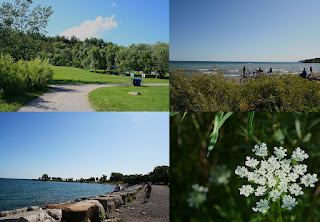 I have often wondered if they had ever done a yearly analysis on the erosion rate of the Scarborough Bluffs, since I had noticed over time a substantial decrease in the height of the mountainous height of sand level. I did find this from a study in 1979.
I have often wondered if they had ever done a yearly analysis on the erosion rate of the Scarborough Bluffs, since I had noticed over time a substantial decrease in the height of the mountainous height of sand level. I did find this from a study in 1979.
"Bluffer's Park, a 2.41km reach of Lake Ontario shoreline in the Borough of
Scarborough, was used as a case
study. The erosion rate, being an annual
measure of a volume of material eroded from a linear metre of
shore linehaving a bluff height of 1 metre
(m3/m/m/yr), was found to be 0.34m3/m/m/yr.) This rate is an average over
the face of the bluff and is in the same
range as the rates normally associated with
other areas of Scarborough Bluffs. "
.
Springs first thaw has created flooding in certain parts of Toronto this year. I've never seen the bluffers with so much overflow, leaving muck piles everywhere. Water is rising due to global warming and I've heard the cottage is flooded, but we'll wait until we can get closer to check it out.
There are certain looks that the Bluff cliffs give that makes me think of Arizona for some reason?
There are certain looks that the Bluff cliffs give that makes me think of Arizona for some reason?

The layers of sand and clay exposed in these
cliffs display a remarkable geological record of the last stages of the
Great Ice Age. Unique in North America, they have attracted worldwide
scientific interest. The first 46 metres of sediments contain fossil
plants and animals that were deposited in a large river delta during the
first advance of the Wisconsinan glacier some 70,000 years ago. They
are covered by 61 metres of boulder clay and sand in alternating layers
left by four subsequent advances and retreats of ice. The final
withdrawal of the glacier occurred some 12,000 years ago.
They also found clay minerals int he triassic rocks in the colorado plateau, which would explain why I relate the two North American sites.














